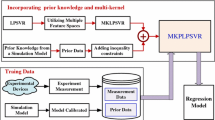Abstract
The paper presents the application of support vector regression technique for the modelling of antennas. Two different antennas were modelled with different properties. The first modelling was for a helical antenna with varying parameters to determine the gain of antenna. In the second modelling, an equilateral triangular patch antenna with varying properties for the design was considered for the determination of the directivity of the antenna. The support vector regression modelled both of the antennas very well. In helical antenna, the radial kernel with ν-regression produced only 0.143 dBi average error. In equilateral triangular patch antenna, the radial kernel with ε-regression produced only 0.126 dBi average error.
Access this chapter
Tax calculation will be finalised at checkout
Purchases are for personal use only
Similar content being viewed by others
References
Zhong, H., Wang, J., Jia, H., Mu, Y., Lv, H.: Vector field-based support vector regression for building energy consumption prediction. Appl. Energy 242, 403–414 (2019). https://doi.org/10.1016/j.apenergy.2019.03.078
Trafalis, T.B., Ince, H.: Support vector machine for regression. In: Proceedings of the IEEE-INNS-ENNS International Joint Conference on Neural Networks. IJCNN 2000. Neural Computing: New Challenges and Perspectives for the New Millennium (2000). https://doi.org/10.1109/ijjcnn.2000.859420
Cheng, J., Yu, D., Yang, Y.: Application of support vector regression machines to the processing of end effects of Hilbert-Huang transform. Mech. Syst. Signal Process. 21(3), 1197–1211 (2007). https://doi.org/10.1016/j.ymssp.2005
Ulker, E.D., Ulker, S.: Unemployment rate and GDP prediction using support vector regression. In: AISS 2019 International Conference on Advanced Information Science and System, Singapore, Article No. 17, pp. 1–5 (2019). https://doi.org/10.1145/3373477.3373494
Yang, P., Zhu, J., **ao, Y., Chen, Z.: Antenna selection for MIMO system based on pattern recognition. Digit. Commun. Netw. 5, 34–39 (2019). https://doi.org/10.1016/j.dcan.2018.10.0001
Tokan, N.T., Güneş, F.: Support vector characterization of the microstrip antennas based on measurements. Prog. Electromagn. Res. B 5, 49–61 (2008). https://doi.org/10.2528/PIERB08013006
Martinez-Ramon, M., Rojo-Alvarez, J.L., Camps-Valls, G., Christodoulou, C.G.: Kernel antenna array processing. IEEE Trans. Antennas Propag. 55(3), 642–650 (2007). https://doi.org/10.1109/TAP.2007.891550
Lin, H., Shin, W.-Y., Joung, J.: Support vector machine-based transmit antenna allocation for multiuser communication systems. Entropy 21, 471 (2019). https://doi.org/10.3390/e21050471
Ulker, S.: Support vector regression analysis for the design of feed in a rectangular patch antenna. In: ISMSIT 3rd International Symposium on Multidisciplinary Innovative Technologies (2019). https://doi.org/10.1109/ismsit.2019.8932929
Angiulli, G., Cacciola, M., Versaci, M.: Microwave devices and antenna modelling by support vector regression machines. IEEE Trans. Magn. 43(4), 1589–1592 (2007). https://doi.org/10.1109/TMAG.2007.892480
Vapnik, V.N., Chervonenkis, A.Y.: The uniform convergence of frequencies of the appearance of events to their probabilities. Dokl. Akad. Nauk SSSR 181(4), 781–783 (1968)
Schölkopf, B., Burges, C., Vapnik, V.: Incorporating invariances in support vector learning machines. In: International Conference on Artificial Neural Networks ICANN, vol. 96, pp. 47–52 (1996)
Haykin, S.: Neural Networks, 2nd edn. Prentice Hall, New Jersey (1999)
Drucker, H., Burges, C.J.C., Kaufman, L., Smola, A., Vapnik, V.: Support vector regression machines. In: Mozer, M.C., Jordan, M.I., Petsche, T. (eds.) Advances in Neural Information Processing Systems 9, pp. 155–161. MIT Press, Cambridge, MA (1997)
Smola, A.J., Schölkopf, B.: A tutorial on support vector regression. Statist. Comput. 14(3), 199–222 (2004)
Khosravi, A., Koury, R.N.N., Machado, L., Pabon, J.J.G.: Prediction of wind speed and wind direction using artificial neural network, support vector regression and adaptive neuro-fuzzy inference system. Sustain. Energy Technol. Assess. 25, 146–160 (2018). https://doi.org/10.1016/j.seta.2018.01.001
Peng, Y., Albuquerque, P.H.M., de Sa, J.M.C., Padula, A.J.A., Montenegro, M.R.: The best of two worlds: forecasting high frequency volatility for cryptocurrencies and traditional currencies with support vector regression. Expert Syst. Appl. 97, 177–192 (2018). https://doi.org/10.1016/j.eswa.2017.12.004
Danandeh Mehr, A., Nourani, V., Karimi Khosrowshahi, V., Ghorbani, M.A.: A hybrid support vector regression–firefly model for monthly rainfall forecasting. Int. J. Environ. Sci. Technol. 16(1), 335–346 (2018). https://doi.org/10.1007/s13762-018-1674-2
Baydaroğlu, Ö., Koçak, K., Duran, K.: River flow prediction using hybrid models of support vector regression with the wavelet transform, singular spectrum analysis and chaotic approach. Meteorol. Atmos. Phys. 130(3), 349–359 (2017). https://doi.org/10.1007/s00703-017-0518-9
Tripathi A., Thakare V.V., Singhal, P.K.: Analysis of different performance parameters of equilateral triangular microstrip patch using artificial neural network. Int. J. Adv. Innov. Thoughts Ideas 2(3) (2013)
Author information
Authors and Affiliations
Corresponding author
Editor information
Editors and Affiliations
Rights and permissions
Copyright information
© 2021 Springer Nature Switzerland AG
About this paper
Cite this paper
Ulker, E.D., Ulker, S. (2021). Determining the Gain and Directivity of Antennas Using Support Vector Regression. In: Arai, K., Kapoor, S., Bhatia, R. (eds) Intelligent Systems and Applications. IntelliSys 2020. Advances in Intelligent Systems and Computing, vol 1250. Springer, Cham. https://doi.org/10.1007/978-3-030-55180-3_5
Download citation
DOI: https://doi.org/10.1007/978-3-030-55180-3_5
Published:
Publisher Name: Springer, Cham
Print ISBN: 978-3-030-55179-7
Online ISBN: 978-3-030-55180-3
eBook Packages: Intelligent Technologies and RoboticsIntelligent Technologies and Robotics (R0)




